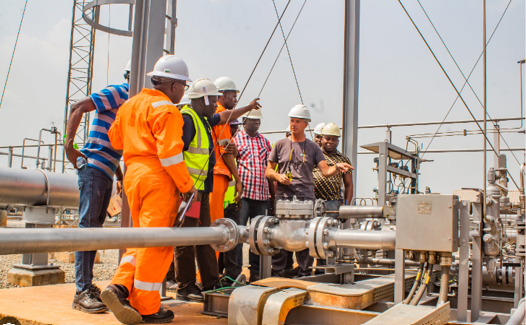In this blog we will be looking at meaning of pipeline pigging, Importance of Pipeline Pigging, Types of Pipeline Pigging Equipment and their uses.
Introduction
Pigging is the practice of using pipeline inspection gauges or gadgets, devices like pigs or scrapers, to perform various maintenance operations. This is done without stopping the flow of the product in the pipeline. These operations include but are not limited to cleaning and inspecting the pipeline. This is accomplished by inserting the pig into a “pig launcher” (or “launching station”) an oversized section in the pipeline, reducing to the normal diameter. The launching station is then closed and the pressure-driven flow of the product in the pipeline is used to push the pig along the pipe until it reaches the receiving trap—the “pig catcher” (or “receiving station”).
What is pipeline pigging?
Pipeline pigging is the implementation of a Pipeline Inspection Gauge device, or “pig” for short, designed to perform pipeline maintenance. A “pig” is a bullet-shaped device that can be used for cleaning and maintenance, product movement, product separation, and inspections of the interior walls of the pipeline. Pigs are made using a variety of materials ranging from steel, foam, or custom to fit the needs of your project. The process of pipeline pigging is done by inserting the pig into the interior of a pipeline using a pig launcher. A pig launcher is a device that launches the pig allowing it to move through the pipeline.
Read: Pipeline Welding in The Oil and Gas Industry/ Meaning/ Types/Facts
Once the process is complete, a pig receiver is used to remove the pig without interfering with the flow of the pipe. To ensure there are no potential leaks or cracks in a pipe, regular in-line inspections should be performed. In-line inspections use a specialty pig called a “smart pig”. Smart pigs can be used in a pipeline to assess its current condition.
Importance of pipeline pigging.
The importance of pipeline pigging cannot be over looked and it helps to maintain continuous operation of the pipeline through the following ways:
- It removes any substance which might damage the pipeline process systems
- helps to prevent the formation of corrosion cells
- Provides timely information of any developing problems
- Provides data on any perceived problems to enable informed decisions to be made.
- Provides an alternative to shutting down for statutory periodic testing.
They help to obtain and maintain maximum efficiency by:
- removing any debris or foreign matter in the line
- removing any deposits, either liquid or solid, which might otherwise build up and restrict the flow by monitoring the operating and/or physical conditions of the line.
Read: Steel Fabrication in the Oil & Gas Industry
Types of Pipeline Pigging Equipment and their Uses
Pipeline pigging is a versatile process employed in various industries to ensure the efficient and safe operation of pipework. Pigs, which come in different shapes and sizes, are inserted into the pipeline and pushed through by the flow of the product or an external propellant. The primary types of pipeline pigging include cleaning pigs, batching pigs, and inspection pigs.
Cleaning pigs: Cleaning pigs are designed to remove debris, sediment, and deposits that accumulate in pipelines over time. These pigs ensure thorough removal of contaminants to maintain optimal pipeline efficiency.
Batching pigs: Batching pigs are used to separate different products within the pipeline, preventing cross-contamination. These pigs are particularly valuable in pipelines that transport multiple products sequentially.
Inspection pigs: Inspection pigs, equipped with advanced sensors and cameras, play a crucial role in assessing the integrity of pipelines. They detect anomalies, corrosion, and structural issues, enabling operators to proactively address potential problems and prevent costly failures.
Pigging Equipment are generally Used for:
- Hydrostatic testing
- Pipeline cleanup
- Batch transportation
- Prevention of solid accumulation and corrosion
- Coating
- Inspection
Pipeline pigging equipment are essential for cleaning, inspecting and maintaining pipelines of all shapes and sizes. Ensure that you have all of the right tools to help monitor and manage your pipeline pigs.

